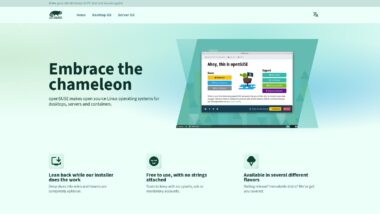Linuxiac Weekly Wrap-Up: Week 34 (Aug 18 – 24, 2025)


 Mozilla’s long-standing antipathy in supporting Progressive Web Apps (PWAs) in Firefox began to thaw earlier this year, as bods behind the browser finally announced plans to embrace them. And if you installed the Firefox 142 release, you can take an early look at the feature — if you’re on Windows, that is. Firefox’s web app features (Taskbar Tabs) is not stable, feature-complete, or enabled by default. It is experimental, and those trying it out should keep that in mind. It can be enabled in Firefox on Windows via Settings > Labs. The feature blurb reads: “Open sites you frequently visit […]
Mozilla’s long-standing antipathy in supporting Progressive Web Apps (PWAs) in Firefox began to thaw earlier this year, as bods behind the browser finally announced plans to embrace them. And if you installed the Firefox 142 release, you can take an early look at the feature — if you’re on Windows, that is. Firefox’s web app features (Taskbar Tabs) is not stable, feature-complete, or enabled by default. It is experimental, and those trying it out should keep that in mind. It can be enabled in Firefox on Windows via Settings > Labs. The feature blurb reads: “Open sites you frequently visit […]
You're reading Firefox Web App Support Available to Test (on Windows, At Least), a blog post from OMG! Ubuntu. Do not reproduce elsewhere without permission.



When Red Hat announced the abrupt end of traditional CentOS in late 2020, the Linux ecosystem was shaken to its core. Developers, sysadmins, and enterprises that relied on CentOS for years suddenly found themselves scrambling for answers. Out of that disruption, two projects, AlmaLinux and Rocky Linux, emerged to carry forward the legacy of CentOS while forging their own identities. This article dives into how these two distributions established themselves as reliable, enterprise-grade options for developers and organizations alike.
For over a decade, CentOS was the backbone of countless servers, from small web hosts to enterprise data centers. It provided a stable, free, and RHEL-compatible platform, perfect for developers and administrators building and maintaining critical infrastructure.
That stability came to an end when Red Hat pivoted CentOS to a rolling-release model, CentOS Stream. Instead of offering a downstream, binary-compatible version of RHEL, Stream became a preview of future RHEL updates. This move caused widespread frustration:
Organizations that built production environments around CentOS suddenly faced shortened support lifecycles.
Developers who depended on a “set-and-forget” environment now had to deal with the unpredictability of a rolling release.
Compliance-driven industries were left in limbo, as running on an unsupported OS could trigger security and regulatory risks.
This disruption created a vacuum, and the Linux community quickly stepped up to fill it.
Shortly after the CentOS announcement, CloudLinux, a company with deep experience in server environments, launched AlmaLinux. The first stable release landed in March 2021. True to its name, “alma” meaning “soul”, the project’s mission was clear: to embody the spirit of CentOS while maintaining community governance. The non-profit AlmaLinux OS Foundation now oversees the project, ensuring it remains free and open for everyone.
Rocky Linux: A Tribute and a PromiseAt almost the same time, Gregory Kurtzer, one of the original CentOS founders, unveiled Rocky Linux, named in honor of CentOS co-founder Rocky McGaugh. From the beginning, Rocky positioned itself as a 1:1 binary-compatible rebuild of RHEL, mirroring CentOS’s original mission. Its governance structure, managed by the Rocky Enterprise Software Foundation (RESF), ensures that the project remains rooted in community oversight rather than corporate ownership.

For over two decades, Eye of GNOME (often shortened to EOG) was the silent workhorse of the GNOME desktop environment. It wasn’t flashy, but it did exactly what most people expected: double-click a picture, and it opened instantly. Yet, with the arrival of GNOME 45 in late 2023, a new name appeared in the lineup of “core” apps: Loupe. From that moment forward, Loupe became the official default image viewer on GNOME desktops, displacing EOG.
This decision wasn’t made lightly. GNOME has been steadily refreshing its default applications in recent years, Gedit was replaced by GNOME Text Editor, and Cheese gave way to Snapshot. Loupe is the continuation of this modernization trend. Eye of GNOME is still available in repositories for those who want it, but the GNOME team has shifted its endorsement to Loupe as the better long-term solution.
Loupe isn’t just a reskin of EOG. It was built from scratch with today’s hardware, design standards, and security expectations in mind. At first glance, the interface looks minimal, but there’s more happening beneath the hood than many realize.
Rust-Powered Foundation – Unlike Eye of GNOME’s decades-old C codebase, Loupe is written in Rust. This choice immediately grants it memory safety, helping avoid whole categories of crashes and vulnerabilities. For an app that regularly opens untrusted files, this is an important safeguard.
GPU-Accelerated Image Handling – Instead of pushing all rendering to the CPU, Loupe leverages the GPU. Panning across a large image or zooming into a 50-megapixel photo feels fluid, even on high-resolution displays.
Touch-Friendly Navigation – GNOME has been preparing for a future that includes more touch devices. Loupe fits right in, supporting pinch-to-zoom, two-finger swipes to move between images, and smooth transitions that feel natural on both touchscreens and trackpads.
Streamlined Metadata View – Instead of burying photo information behind a separate dialog, Loupe integrates an optional sidebar. With a click, you can see dimensions, file size, EXIF data, and even location details without leaving the main view.
Security Through Sandboxing – Image decoding is handled in isolated processes using a new backend called Glycin. If a corrupt or malicious image tries to crash the decoder, it won’t take the entire viewer down with it.